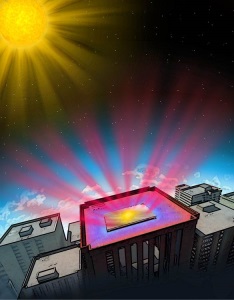
by Brianna Crandall — December 10, 2014—Engineers from Stanford University have invented a “revolutionary” coating material that they say can help cool buildings, even on sunny days, by radiating heat away from the buildings and sending it directly into space.
A team led by electrical engineering Professor Shanhui Fan and research associate Aaswath Raman reported this potentially energy-saving breakthrough in the journal Nature.
The ultrathin, multilayered material reportedly deals with light, both invisible and visible, in a new way. The material shunts invisible, heat-bearing light (such as is felt in front of a closed hot oven) away from buildings and sends it into space; it also acts as a “stunningly efficient” mirror that reflects virtually all of the incoming sunlight that strikes it.
The result is what the Stanford team calls “photonic radiative cooling” — a “one-two punch” that offloads infrared heat from within a building while also reflecting the sunlight that would otherwise warm it up. The result is expected to be cooler buildings that require less air conditioning. The researchers say they designed the material to be cost-effective for large-scale deployment on building rooftops, and they believe it could one day reduce demand for electricity.
In practice, the researchers surmise the coating might be sprayed on a more solid material to make it suitable for withstanding the elements.




